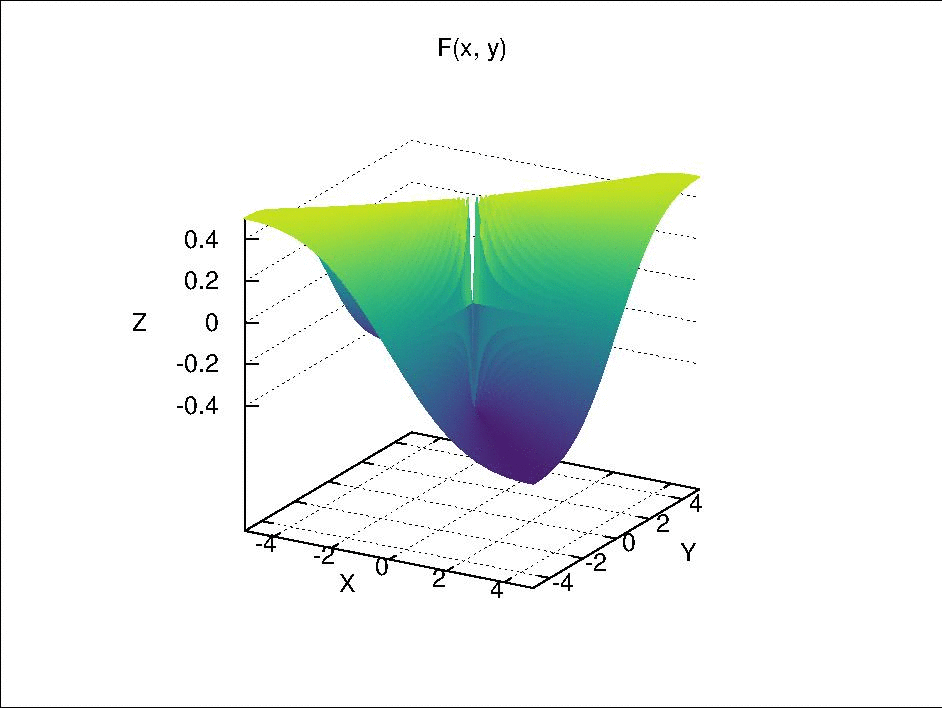James Munkres Topology: Sec 18 Exer 12
Theorem 18.4 in James Munkres “Topology” states that if a function \(f : A \rightarrow X \times Y\) is continuous, its coordinate functions \(f_1 : A \rightarrow X\) and \(f_2 : A \rightarrow Y\) are also continuous, and the converse is also true. This is what we have been familiar with, such as a continuous parametric curve \(f: [0, 1] \rightarrow \mathbb{R}^3\) defined as \(f(t) = (x(t), y(t), z(t))^T\) with its three components being continuous. However, if a function \(g: A \times B \rightarrow X\) is separately continuous in each of its components, i.e. both \(g_1: A \rightarrow X\) and \(g_2 : B \rightarrow X\) are continuous, \(g\) is not necessarily continuous.
Here, the said “separately continuous in each of its components” means arbitrarily selecting the value of one component variable from its domain and fix it, then the original function depending only on the other component is continuous. In the above, the function \(g\) can be envisaged as a curved surface in 3D space. With \(g_1\) being continuous, the intersection profiles between this curved surface and those planes perpendicular to the coordinate axis for \(B\) are continuous. Similarly, because \(g_2\) is continuous, the intersection profiles obtained from those planes perpendicular to the coordinate axis for \(A\) are also continuous. The continuity of intersection curves is only ensured in these two special directions, so it is not guaranteed that the original function \(g\) is continuous.
In Exercise 12 of Section 18, an example is given as
\[
F(x \times y) = \begin{cases}
\frac{xy}{x^2 + y^2} & (x \neq 0, y \neq 0) \\
0 & (x = 0, y = 0)
\end{cases},
\]
where \(F\) is continuous separately in each of its component variables but is not continuous by itself. This is function is visualized below.

Fix \(y\) at \(y_0\), we have \(F_{y_0}(x) = F(x \times y_0)\). When \(y_0 \neq 0\), \(F_{y_0}(x)\) is continuous with respect to \(x\) because it is only a composition of continuous real valued functions via simple arithmetic. When \(y_0 = 0\), if \(x \neq 0\), \(F_0(x) = 0\); if \(x =0\), \(F_0(x)\) is also 0 due to the definition of \(F(x \times y)\). Therefore, \(F_0(x)\) is a constant function, which is continuous due to Theorem 18.2 (a). Similarly, \(F_{x_0}(y)\) is also continuous with respect to \(y\).
However, if we let \(x = y\) and approach \((x, y) = (x, x)\) to \((0, 0)\), it can be seen that \(F(x \times x)\) is not continuous, because
- when \(x \neq 0\), \(F(x \times x) = \frac{x^2}{x^2 + x^2} = \frac{1}{2}\);
- when \(x = 0\), \(F(x \times x) = 0\).
If we let \(x = -y\) and approach \((x ,y) = (x, -x)\) to \((0, 0)\), \(F = -\frac{1}{2}\) when \(x \neq 0\) and \(F = 0\) when \(x = 0\).
Then, if we select an open set such as \((-\frac{1}{4}, \frac{1}{4})\) around the function value \(0\) in \(\mathbb{R}\), its pre-image \(U\) in \(\mathbb{R} \times \mathbb{R}\) should include the point \((0, 0)\) and exclude the rays \((x, x)\) and \((x, -x)\) with \(x \in \mathbb{R}\) and \(x \neq 0\). Due to these excluded rays, there is no neighborhood of \((0, 0)\) in \(\mathbb{R} \times \mathbb{R}\) that is contained completely in \(U\). Therefore, \(U\) is not an open set and \(F(x \times y)\) is not continuous.
From the above analysis, some lessons can be learned.
- Pure analysis can be made and general conclusions can be obtained before entering into the real world with a solid example.
- A tangible counter example is a sound proof for negation of a proposition. Just one is enough!
James Munkres Topology: Sec 18 Exer 12的更多相关文章
- James Munkres Topology: Sec 22 Exer 3
Exercise 22.3 Let \(\pi_1: \mathbb{R} \times \mathbb{R} \rightarrow \mathbb{R}\) be projection on th ...
- James Munkres Topology: Sec 22 Exer 6
Exercise 22.6 Recall that \(\mathbb{R}_{K}\) denotes the real line in the \(K\)-topology. Let \(Y\) ...
- James Munkres Topology: Sec 37 Exer 1
Exercise 1. Let \(X\) be a space. Let \(\mathcal{D}\) be a collection of subsets of \(X\) that is ma ...
- James Munkres Topology: Sec 22 Example 1
Example 1 Let \(X\) be the subspace \([0,1]\cup[2,3]\) of \(\mathbb{R}\), and let \(Y\) be the subsp ...
- James Munkres Topology: Theorem 19.6
Theorem 19.6 Let \(f: A \rightarrow \prod_{\alpha \in J} X_{\alpha}\) be given by the equation \[ f( ...
- James Munkres Topology: Lemma 21.2 The sequence lemma
Lemma 21.2 (The sequence lemma) Let \(X\) be a topological space; let \(A \subset X\). If there is a ...
- James Munkres Topology: Theorem 20.3 and metric equivalence
Proof of Theorem 20.3 Theorem 20.3 The topologies on \(\mathbb{R}^n\) induced by the euclidean metri ...
- James Munkres Topology: Theorem 20.4
Theorem 20.4 The uniform topology on \(\mathbb{R}^J\) is finer than the product topology and coarser ...
- James Munkres Topology: Theorem 16.3
Theorem 16.3 If \(A\) is a subspace of \(X\) and \(B\) is a subspace of \(Y\), then the product topo ...
随机推荐
- python之数据类型补充、集合、深浅copy
一.内容回顾 代码块: 一个函数,一个模块,一个类,一个文件,交互模式下,每一行就是一个代码块. is == id id()查询对象的内存地址 == 比较的是两边的数值. is 比较的是两边的内存地址 ...
- DRF之版本控制、认证和权限组件
一.版本控制组件 1.为什么要使用版本控制 首先我们开发项目是有多个版本的当我们项目越来越更新,版本就越来越多,我们不可能新的版本出了,以前旧的版本就不进行维护了像bootstrap有2.3.4版本的 ...
- (二叉树 DFS 递归) leetcode 112. Path Sum
Given a binary tree and a sum, determine if the tree has a root-to-leaf path such that adding up all ...
- Pandas系列(十一)-文件IO操作
数据分析过程中经常需要进行读写操作,Pandas实现了很多 IO 操作的API,这里简单做了一个列举. 格式类型 数据描述 Reader Writer text CSV read_ csv to_cs ...
- mui扩展字体在哪里下载
一次在一个知名前端模板网站上用积分下载了一个手机网页模板,没想到作者竟然玩起了删减隐藏,故意挖坑. 查看其原因是少一个mui.ttf的文件,纵然其他的文件及名称都有删改但无关紧要.也就是好多人搜索的m ...
- vue开发常用插件
dependencies axios // 用于请求数据 better-scroll // 用于处理页面列表的滚动,下拉刷新等 fastclick // 用于处理移动设备点击会有300毫秒延迟的问题 ...
- IE提示“Internet Explorer已限制此网页运行脚本或ActiveX控件”的解决办法
在页面html开始标签和head开始标签中间新增一行,添加以下代码: <!-- saved from url=(0014)about:internet --> 或者 直接设置IE浏览器 工 ...
- LFYZ-OJ ID: 1010 天使的起誓
思路 理解题目后,会发现是一个高精度除低精度求余问题,非常简单. 容易出错的地方是:求余结果为0的时候,此时,天使所在的盘子号码其实就是n,如果直接返回余数,得到的结果则是0. 被除数的范围是2-10 ...
- 第四节:框架前期准备篇之进程外Session的两种配置方式
一. 基本介绍 1. 背景:Asp.Net默认的Session机制是进程内,存储在服务器端内存中,有这么几个缺点: ①:既然存在内存中,空间有限,不能存储大数据量信息,数据量多的话Session会被挤 ...
- PL/SQl编程 基本语法
/*输出hello world*/ DECLARE BEGIN DBMS_OUTPUT.PUT_LINE('Hello World'); END; --set serveroutput on; /** ...
